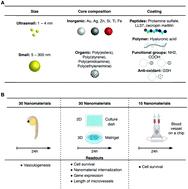当前位置:
X-MOL 学术
›
Nanoscale Horiz.
›
论文详情
Our official English website, www.x-mol.net, welcomes your feedback! (Note: you will need to create a separate account there.)
Induced pluripotent stem cell-derived vascular networks to screen nano–bio interactions
Nanoscale Horizons ( IF 9.7 ) Pub Date : 2021-2-12 , DOI: 10.1039/d0nh00550a Luís Estronca 1 , Vitor Francisco , Patrícia Pitrez , Inês Honório , Lara Carvalho , Helena Vazão , Josephine Blersch , Akhilesh Rai , Xavier Nissan , Ulrich Simon , Mário Grãos , Leonor Saúde , Lino Ferreira
Nanoscale Horizons ( IF 9.7 ) Pub Date : 2021-2-12 , DOI: 10.1039/d0nh00550a Luís Estronca 1 , Vitor Francisco , Patrícia Pitrez , Inês Honório , Lara Carvalho , Helena Vazão , Josephine Blersch , Akhilesh Rai , Xavier Nissan , Ulrich Simon , Mário Grãos , Leonor Saúde , Lino Ferreira
Affiliation

|
The vascular bioactivity/safety of nanomaterials is typically evaluated by animal testing, which is of low throughput and does not account for biological differences between animals and humans such as ageing, metabolism and disease profiles. The development of personalized human in vitro platforms to evaluate the interaction of nanomaterials with the vascular system would be important for both therapeutic and regenerative medicine. A library of 30 nanoparticle (NP) formulations, in use in imaging, antimicrobial and pharmaceutical applications, was evaluated in a reporter zebrafish model of vasculogenesis and then tested in personalized humanized models composed of human-induced pluripotent stem cell (hiPSC)-derived endothelial cells (ECs) with “young” and “aged” phenotypes in 3 vascular network formats: 2D (in polystyrene dish), 3D (in Matrigel) and in a blood vessel on a chip. As a proof of concept, vascular toxicity was used as the main readout. The results show that the toxicity profile of NPs to hiPSC-ECs was dependent on the “age” of the endothelial cells and vascular network format. hiPSC-ECs were less susceptible to the cytotoxicity effect of NPs when cultured in flow than in static conditions, the protective effect being mediated, at least in part, by glycocalyx. Overall, the results presented here highlight the relevance of in vitro hiPSC-derived vascular systems to screen vascular nanomaterial interactions.
中文翻译:

诱导多能干细胞衍生的血管网络筛选纳米生物相互作用
纳米材料的血管生物活性/安全性通常通过动物试验进行评估,其通量较低,且未考虑动物与人类之间的生物学差异,例如衰老、代谢和疾病谱。体外个性化人体的开发评估纳米材料与血管系统相互作用的平台对于治疗和再生医学都很重要。在成像、抗菌和制药应用中使用的 30 种纳米颗粒 (NP) 制剂库在血管生成的报告斑马鱼模型中进行评估,然后在由人诱导多能干细胞 (hiPSC) 衍生的内皮细胞组成的个性化人源化模型中进行测试具有“年轻”和“老化”表型的 3 种血管网络格式的细胞 (EC):2D(在聚苯乙烯培养皿中)、3D(在基质胶中)和芯片上的血管中。作为概念证明,血管毒性被用作主要读数。结果表明,NPs 对 hiPSC-ECs 的毒性取决于内皮细胞的“年龄”和血管网络形式。与静态条件相比,hiPSC-EC 在流动培养时对 NPs 的细胞毒性作用更不敏感,保护作用至少部分由糖萼介导。总的来说,这里呈现的结果强调了用于筛选血管纳米材料相互作用的体外hiPSC 衍生血管系统。
更新日期:2021-02-12
中文翻译:

诱导多能干细胞衍生的血管网络筛选纳米生物相互作用
纳米材料的血管生物活性/安全性通常通过动物试验进行评估,其通量较低,且未考虑动物与人类之间的生物学差异,例如衰老、代谢和疾病谱。体外个性化人体的开发评估纳米材料与血管系统相互作用的平台对于治疗和再生医学都很重要。在成像、抗菌和制药应用中使用的 30 种纳米颗粒 (NP) 制剂库在血管生成的报告斑马鱼模型中进行评估,然后在由人诱导多能干细胞 (hiPSC) 衍生的内皮细胞组成的个性化人源化模型中进行测试具有“年轻”和“老化”表型的 3 种血管网络格式的细胞 (EC):2D(在聚苯乙烯培养皿中)、3D(在基质胶中)和芯片上的血管中。作为概念证明,血管毒性被用作主要读数。结果表明,NPs 对 hiPSC-ECs 的毒性取决于内皮细胞的“年龄”和血管网络形式。与静态条件相比,hiPSC-EC 在流动培养时对 NPs 的细胞毒性作用更不敏感,保护作用至少部分由糖萼介导。总的来说,这里呈现的结果强调了用于筛选血管纳米材料相互作用的体外hiPSC 衍生血管系统。



























 京公网安备 11010802027423号
京公网安备 11010802027423号